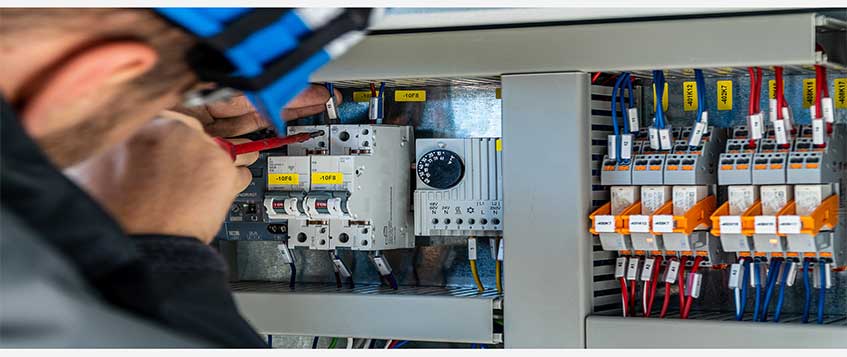
Control panels, like many other custom-built goods, have varying degrees of quality. These variances can be hard to identify, but over the course of time it is easy to see how well made, quality control panels stand the test of time when others fail and result in lost production.
This whitepaper outlines the differences in control panel quality and helps to give an understanding of the building blocks of control panels that are the most efficient and cost effective choice for the manufacturing process. In addition, this paper touches on some of the rules and entities that influence the industrial controls market-including such things as design, following guidelines, and actual panel build.
A great build starts with design. Unfortunately, in an effort to lower the cost of panel building many control panel shops cut corners by implementing weak design standards which -in the long run-result in reduced production time for the customer.
Weak design standards are a result of using generic drawings that have only minor adjustments to detail. These drawings use simple shapes, rough component placements, and simple wire numbering which causes setbacks with installation, as electricians and maintenance personnel try to decipher vague controls drawings. Then, later in the process if a breakdown occurs, maintenance once again is tasked with trying to decipher poorly created drawings while precious minutes and hours tick away.
Elements of good design are created by using clear and detailed drawings that include the proper use of symbols, designated space for growth, and that adhere to control panel industry guidelines and standard practices.
Clear and Detailed Drawings
Electrical drawings should be designed to give the builder a clear understanding for constructing the panel and also give the end user a valuable document. The drawing should include a layout that closely represents the components in the control panel. In addition, the layout should also have a general flow that separates- as much as possible-lower voltages from higher voltages, and provide a space for all field wiring to be landed.
Proper Use of Symbols
Good drawings also have indicators to assist the reader such as “boxing around” wire points that are outside the control panel-like a motor or sensor.
Proper use of symbols helps maintenance to quickly see where different components such as pushbuttons, selector switches, sensors and E-stop type pushbuttons are drawn.
Allocating Space for Growth
One last point to cover with design elements is space. Rarely does a control panel get installed and never modified. Troubleshooting, changing production needs, and automation advancements are just a few reasons for working in and needing room for additional components to a control panel.
The real test for the design team is how to allocate space for growth. Planning for at least 10% growth should be integrated into the control center schematics. It is easy to drop in the components and have space clumped. However, the best designs will have spacing allowances for every segment.
The automation area will allow for additional I/O cards to be added, motor control will allow for additional service(s), terminal points will have room to allow additional field points, and wire ways will have space available for additional wires needed.
The controls provider should be told about potential future plans. With advanced knowledge, the panel should be able to be designed with the proper space to implement new components. The drawings can be created showing future components with the wire addressing and wire points already identified. This step may not seem important at the time of purchase, but maintenance staff will appreciate it when they need to implement and troubleshoot later.
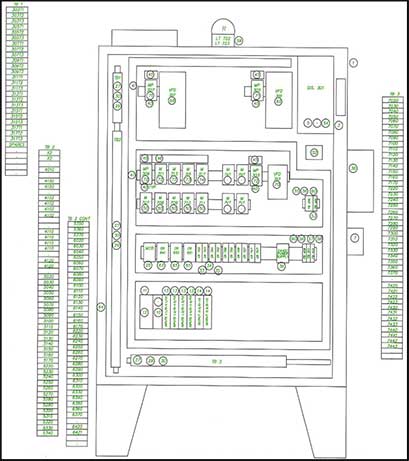
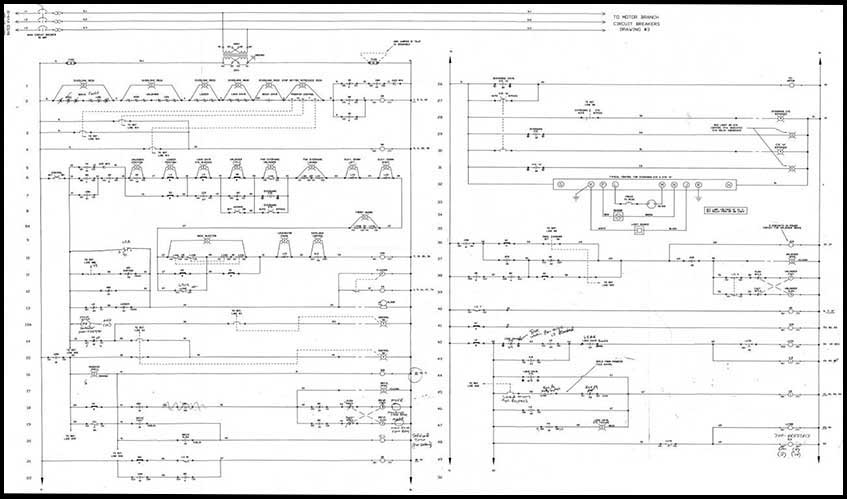
Industrially speaking, most control centers are custom built to the specific need, but unfortunately most panel builders only follow the minimal guidelines for wire size and fusing when designing and building controls—but nothing more. Component spacing, heat dissipation, and many other safe design practices are often skimmed over. These practices have allowed some electrical controls builders to offer the customer lower cost options, but the end the customer typically pays more.
The Interior Control Panel Environment
Many components that fail are simply replaced and assumed to have failed on their own accord, when in reality the environment is the root cause. For example: Variable Frequency Drives (VFDs) generate heat. VFDs that are not spaced properly create a window of heat between them that will most certainly cause premature failure. Furthermore, if the heat being generated is not dissipated or air conditioned, the entire control panel will heat and components susceptible to heat will fail.
Proper Electrical Practices
In the United States, proper electrical practices are set by entities such as the National Electric Code (NEC), United Listing (UL), and others depending on the facilities location.
In the United States, all municipalities have some degree of regulation when it comes to industrial electrical controls and they typically follow closely to the NEC standards. Most municipalities do not actively inspect industrial controls in their area. The controls industry knows this, and many exploit the fact. This creates a large pricing disadvantage to those companies that do not waiver on proper standards.
However, some municipalities are active and some even require that controls be built according to UL standards and stickered by a UL approved shop. Controls builders that are UL listed are subject to routine inspections of their work and will lose their accreditation if they cannot comply to UL’s rules regarding design and construction.
But just because a shop is UL Listed does not mean that they must follow UL rules on all control panels they build. UL Listed control shops are only required to follow UL rules if the panel in question will receive a UL sticker identifying it as a UL Listed control panel.
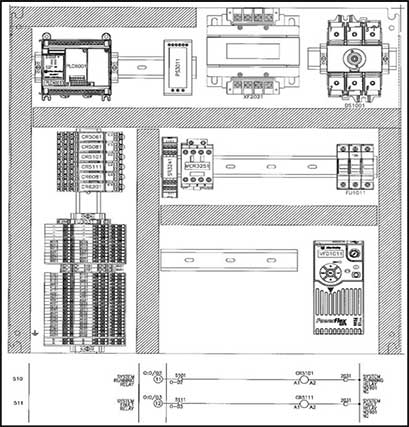
There are subtle differences in the actual build of control panels that can be spotted in order to identify a product that will withstand the test of time from one that will end up costing downtime.
The illustration above is an examples of a high quality layout with proper identification. This drawing gives a true representation of the controls structure, good spacing, and even room for growth and labeling that identifies where parts can be found in the drawings. In the bottom schematic 2 relays are shown, how they are represented, and addressing. Looking at the numbers to the left, this page 5 row 10 & 11. CR5101 shows a relay located on page 5, row 10 and the first relay. If a second relay coil was wired in series, it would be CR5102 and so on. Additionally, the O:0/02 represents the output point for the PLC controller so the technician can easily see the circuit from start to finish.
Electrical Wires
Electrical wire has many variations. Insulation color, Insulation type, gauge (thickness), conductive material, and strand size are all variables. Each variable has its use, but many times the panel will be constructed using the cheapest variable instead of the wire type designed for a specific application. For example, Machine Tool Wire (MTW) and Thermoplastic High Heat-Resistant Nylon Coated (THHN) can be used in control panel construction and both have a practical use, but many panel builders will use the cheapest to serve all connection points.
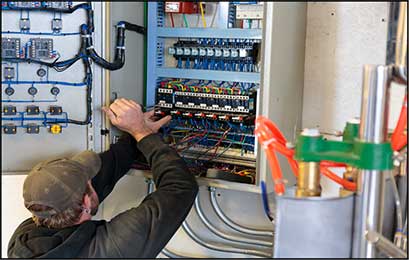
When it comes to color, different wire colors represent different use. Common wire color associations are as follows in regards to AC industrial controls):
Other wire color variations can be applied depending on application. For instance, an orange or purple wire inside a control panel might indicate voltage applied is coming from a source outside this control panel and serves as a warning to the maintenance person that voltage may be present even if control power is off.
Many industrial facilities have taken the step to create guidelines for wire type, color, and use. This practice has been implemented to provide a clear understanding of how power is being used and acts as a safety measure for their maintenance staff. If an operation has not adopted its own wiring practices, they should ensure that the panel is constructed using best practices.
Component Quality
For every component that resides in your control panel, there are a vast number of vendors who supply each part—and cheap. Products that seemingly doing the same job can swing greatly in price. For the consumer, it can be inviting to use the lowest cost component to do the job. However, this is most often not the best choice.
Take a terminal, one of the simplest components in a control panel. Many companies do a good job making these and lower cost units may be suitable for some if not most applications. Compare that to a relay. A relay is also a very simple component, but variances in quality swing as widely as the price and tracing a relay issue can be costly because it does not always go bad all at once. The failure can be intermittent, and this is most prevalent in lower quality units.
As the consumer, the best way to isolate yourself from quality issues versus paying too much is to find a trustworthy source for your controls needs. A trustworthy source will be able to provide controls that they stand behind with a warranty. They should also take the time to understand the customer’s needs and will serve to fill that need.
Assessing Construction
Components should be firmly mounted with acceptable spacing, and wiring should not be tight or binding.

Stored Electrical Parts and Build Area Environment
In many cases, electrical components are sensitive to climate, dust, and other debris. At a minimum, the controls should be built in a room free of dust and debris and electronic parts should be stored in a climate-controlled room. Stock should be rotated, maintained in original packaging, and not stored directly on the floor.
Ideally, controls are built in a fully climate-controlled location specifically purposed for building controls. Many companies will provide several services such as metal fabrication and cutting alongside their control’s efforts. Although this efficient use of space may allow them to provide a lower cost to their customer, the life-cycle of the parts contained within the enclosure may have been substantially shortened.
Panel Testing
Rarely-if ever-should a control panel be shipped from its place of origin before it has at least been run through a power cycle. A power cycle is designed to test for short circuit and general operation before being field wired to the equipment. A power cycle test should not be confused with a Factory Acceptance Test (FAT) or a Site Acceptance Test (SAT). However, if a FAT and SAT test is required for a specific application, the controls builder should be able to offer these services if they are needed.
When looking for a control panel supplier it will be beneficial to ask them the following basic questions, which should be easy to answer. These questions help to identify whether or not the supplier provides quality panels that give the most efficient, long lasting, low maintenance, and profitable solution.
Some additional information to know when purchasing controls includes:
In conclusion, hopefully this article has helped give an understanding of the basics for identifying a high-quality control panel and has also provided good insight on what to look for in a controls provider and purchase.

Larry West is the Sales and Automation Manager for KMC Global Controls & Automation and has more than 18 years of field service and engineering experience-including electrical engineering-in a wide variety of industries including process manufacturing, metalworking operations, and more. KMC Global Controls & Automation provides a single point of contact for a wide variety of industrial controls and automation needs.